法律英语中的破折号和连字符
- 格式:doc
- 大小:11.00 KB
- 文档页数:2
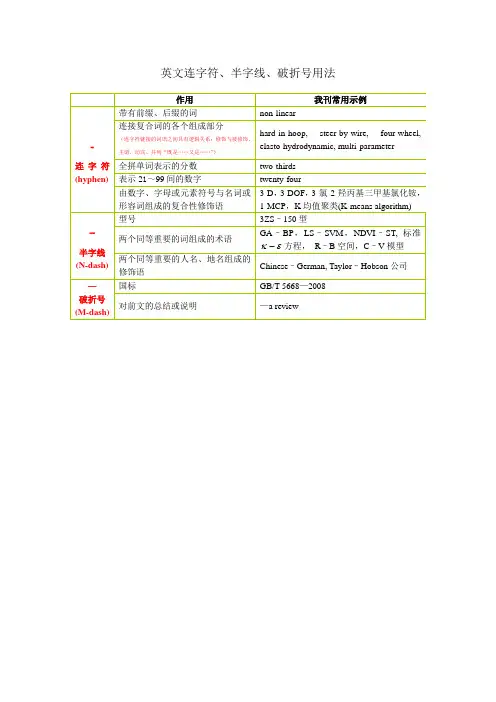
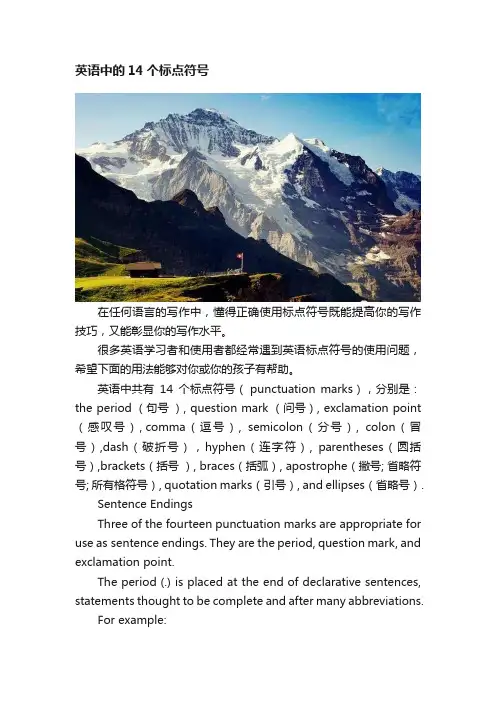
英语中的14个标点符号在任何语言的写作中,懂得正确使用标点符号既能提高你的写作技巧,又能彰显你的写作水平。
很多英语学习者和使用者都经常遇到英语标点符号的使用问题,希望下面的用法能够对你或你的孩子有帮助。
英语中共有14个标点符号( punctuation marks),分别是:the period (句号), question mark (问号), exclamation point (感叹号), comma(逗号), semicolon(分号), colon(冒号),dash(破折号),hyphen(连字符), parentheses(圆括号),brackets(括号), braces(括弧), apostrophe(撇号; 省略符号; 所有格符号), quotation marks(引号), and ellipses(省略号).Sentence EndingsThree of the fourteen punctuation marks are appropriate for use as sentence endings. They are the period, question mark, and exclamation point.The period (.) is placed at the end of declarative sentences, statements thought to be complete and after many abbreviations.For example:· As a sentence ender: Jane and Jack went to the market .· After an abbreviation: Her Mar . birthday came and went.Use a question mark (?) to indicate a direct question when placed at the end of a sentence. For example: When did Jane leave for the market ?The exclamation point/mark (!) is used when a person wants to express a sudden outcry or add emphasis.· Within dialogue: “Holy cow!” screamed Jane.· To emphasize a point: My mother-in-law's rants make me furious !Comma, Semicolon and ColonThe comma, semicolon and colon are often misused because they all can indicate a pause in a series.The comma is used to show a separation of ideas or elements within the structure of a sentence. Additionally, it is used in letter writing after the salutation and closing.· Separating elements within sentences : Suzi wanted the black , green , and blue shoes.· Letter Salutations: Dear Uncle John ,·Separation of two complete sentences: We went to the movies , and we went to the beach.The semicolon (;) is used to connect independent clauses. It shows a closer relationship between the clauses than a period would show. For example: John was hurt ; he knew she only said it to upset him.A colon (:) has two main uses:1. The first is after a word introducing a quotation, an explanation, an example, or a series. It is also often used after the salutation of a business letter.2. The second is within time expressions. Within time, it isused to separate out the hour and minute: 12 : 15 p.m.Dash and the HyphenTwo kinds of dashes are used throughout written communications. They are the endash (短破折号) and the emdash (长破折号). An endash is a symbol (-) that is used in writing or printing to connect numbers or to connect elements of a compound adjective, such as 1880 - 1945 or Princeton - New York trains.However, the emdash has more complicated grammatical use. The symbol of is used to:1. Indicate a break in thought or sentence structure2. Introduce a phrase added for emphasis, definition, or explanation3. Separate two clausesUse it in the following manner: We only wanted to get two birds - but the clerk talked us into four pregnant parakeets.A hyphen (-) is the same symbol as the endash. However, it has slightly different usage rules. A hyphen is used between the parts of a compound word or name or between the syllables of a word, especially when divided at the end of a line of text.Examples of this in use include:· Between a compound name: Mrs. Smith - Reynolds· Within a compound word: back - to - backBrackets, Braces and ParenthesesBrackets, braces and parentheses are symbols used to contain words that are a further explanation or are considered a group.Parentheses ( () ) are curved notations used to contain further thoughts or qualifying remarks. However, parentheses can be replaced by commas without changing the meaning inmost cases. For example: John and Jane ( who were actually half brother and sister ) both have red hair.Brackets are the squared off notations ([]) used for technical explanations. YourDictionary uses them when you look up word definitions. At the bottom of each definition page, brackets surround a technical description of where the word originated.Braces ({}) are used to contain two or more lines of text or listed items to show that they are considered as a unit. They are not commonplace in most writing, but can be seen in computer programming to show what should be contained within the same lines.Apostrophe, Quotation Marks and EllipsesThe final three punctuation forms in English grammar are the apostrophe, quotation marks and ellipses. Unlike previously mentioned grammatical marks, they are not related to one another in any form.An apostrophe (') is used to indicate the omission of a letter or letters from a word, the possessive case, or the plurals of lowercase letters.Examples of the apostrophe in use include:·Omission of letters from a word: An issue of nat'l importance.· Possesive case: Sara's dog bites.· Plural for lowercase letters: Six people were told to mind their p's and q's. It should be noted that, according to Purdue University, some teachers and editors enlarge the scope of the use of apostrophe, and prefer their use on symbols (&'s), numbers (7's) and capitalized letters (Q&A's), even though they are not necessary.Quotations marks ( “” ) are a pair of punctuation marksused primarily to mark the beginning and end of a passage attributed to another and repeated word for word. They are also used to indicate meanings and to indicate the unusual or dubious status of a word.Single quotation marks (') are used most frequently for quotes within quotes.The ellipses mark is generally represented by three periods (. . . ) although it is occasionally demonstrated with three asterisks (***). The ellipses are used in writing or printing to indicate an omission, especially of letters or words. Ellipses are frequently used within quotations to jump from one phrase to another, omitting unnecessary words that do not interfere with the meaning. Students writing research papers or newspapers quoting parts of speeches will often employ ellipses to avoid copying lengthy text that is not needed.Differences in British vs. American EnglishThere are a few differences between punctuation in British and American English. The following charts details some of those differences:British EnglishAmerican English The “ . “ symbol is calleda full stop a period The “ ! “ symbol is called an exclamation mark an exclamationpointThe “ ( )“ symbols are calledbrackets parenthesesThe “ [ ]“ symbols are calledsquare brackets bracketsThe position of quotation marks Joy means “happiness”. Joy means“happiness.”The punctuation Dr, Mr, Mrs, Dr., Mr., Mrs.,for abbreviations St, Rd, Ct St., Rd., Ct.。
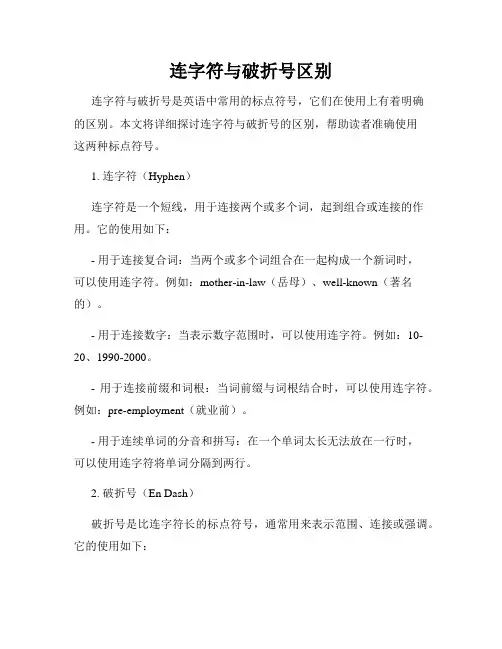
连字符与破折号区别连字符与破折号是英语中常用的标点符号,它们在使用上有着明确的区别。
本文将详细探讨连字符与破折号的区别,帮助读者准确使用这两种标点符号。
1. 连字符(Hyphen)连字符是一个短线,用于连接两个或多个词,起到组合或连接的作用。
它的使用如下:- 用于连接复合词:当两个或多个词组合在一起构成一个新词时,可以使用连字符。
例如:mother-in-law(岳母)、well-known(著名的)。
- 用于连接数字:当表示数字范围时,可以使用连字符。
例如:10-20、1990-2000。
- 用于连接前缀和词根:当词前缀与词根结合时,可以使用连字符。
例如:pre-employment(就业前)。
- 用于连续单词的分音和拼写:在一个单词太长无法放在一行时,可以使用连字符将单词分隔到两行。
2. 破折号(En Dash)破折号是比连字符长的标点符号,通常用来表示范围、连接或强调。
它的使用如下:- 用于表示范围:当表示一个范围时,可以使用破折号。
例如:2010–2015、9:00–11:00。
- 用于连接部分名词:当表示两个或多个词之间有某种关系或连接时,可以使用破折号。
例如:Paris–London(巴黎到伦敦的航班)。
- 用于强调:当需要强调某个词或短语时,可以使用破折号。
例如:他是我们公司的——冠军。
总结:连字符(Hyphen)用于连接词、数字、前缀和词根,以及分隔长单词到两行。
破折号(En Dash)用于表示范围、连接名词,以及强调特定的词或短语。
以上就是连字符与破折号的区别。
正确地使用这两种标点符号,不仅可以使文章更加准确和清晰,同时也提升了文章的整体质量。
希望本文能够帮助读者理解并正确运用连字符与破折号。

在英语中,破折号通常用于连接两个或多个单词,以形成一个复合词或短语。
这种构词方式在英语中很常见,尤其在科学、技术、法律和学术领域。
例如:
1.Post-World War II - 第二次世界大战之后
2.Pre-Hispanic - 西班牙人征服之前的
3.Pro-choice - 支持选择的
此外,破折号还用于表示插入的评论或补充信息。
例如:
1.He - the former president - is still popular among the elderly. - 他(前总统)在老年人
中仍然很受欢迎。
(插入语)
2.Mary - a doctor and a mother of two - is a role model for many women. - 玛丽(一名医
生和两个孩子的母亲)是许多女性的榜样。
(插入语)
总的来说,破折号在英语构词和句子中都起着重要作用。
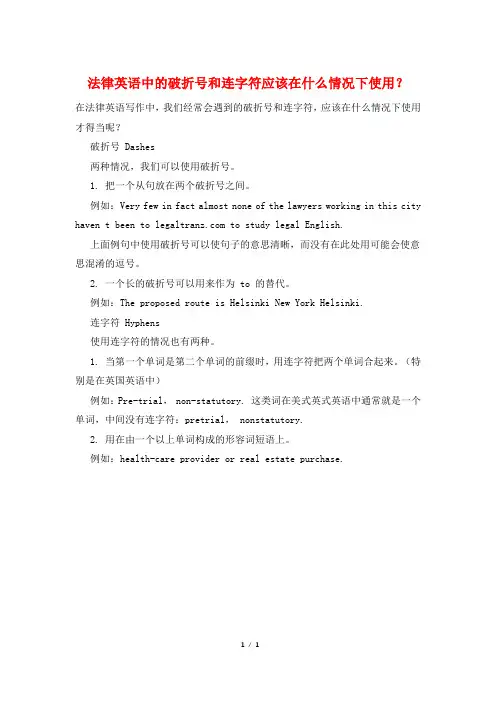
法律英语中的破折号和连字符应该在什么情况下使用?
在法律英语写作中,我们经常会遇到的破折号和连字符,应该在什么情况下使用才得当呢?
破折号 Dashes
两种情况,我们可以使用破折号。
1. 把一个从句放在两个破折号之间。
例如:Very few in fact almost none of the lawyers working in this city haven t been to to study legal English.
上面例句中使用破折号可以使句子的意思清晰,而没有在此处用可能会使意思混淆的逗号。
2. 一个长的破折号可以用来作为 to 的替代。
例如:The proposed route is Helsinki New York Helsinki.
连字符 Hyphens
使用连字符的情况也有两种。
1. 当第一个单词是第二个单词的前缀时,用连字符把两个单词合起来。
(特别是在英国英语中)
例如:Pre-trial, non-statutory. 这类词在美式英式英语中通常就是一个单词,中间没有连字符:pretrial, nonstatutory.
2. 用在由一个以上单词构成的形容词短语上。
例如:health-care provider or real estate purchase.
1/ 1。
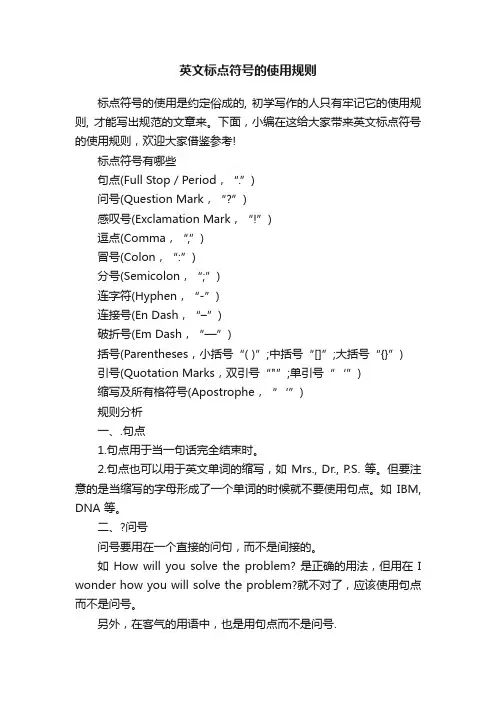
英文标点符号的使用规则标点符号的使用是约定俗成的, 初学写作的人只有牢记它的使用规则, 才能写出规范的文章来。
下面,小编在这给大家带来英文标点符号的使用规则,欢迎大家借鉴参考!标点符号有哪些句点(Full Stop / Period,“.”)问号(Question Mark,“?”)感叹号(Exclamation Mark,“!”)逗点(Comma,“,”)冒号(Colon,“:”)分号(Semicolon,“;”)连字符(Hyphen,“-”)连接号(En Dash,“–”)破折号(Em Dash,“—”)括号(Parentheses,小括号“( )”;中括号“[]”;大括号“{}”)引号(Quotation Marks,双引号“"”;单引号“‘”)缩写及所有格符号(Apostrophe,“‘”)规则分析一、.句点1.句点用于当一句话完全结束时。
2.句点也可以用于英文单词的缩写,如 Mrs., Dr., P.S. 等。
但要注意的是当缩写的字母形成了一个单词的时候就不要使用句点。
如IBM, DNA 等。
二、?问号问号要用在一个直接的问句,而不是间接的。
如 How will you solve the problem? 是正确的用法,但用在 I wonder how you will solve the problem?就不对了,应该使用句点而不是问号。
另外,在客气的用语中,也是用句点而不是问号.如 Will you please give me a call tomorrow.三、! 感叹号感叹号用于感叹和惊叹的陈述中,在商业写作中要注意感叹号的应用,因为不恰当的使用会显得突兀及不稳重。
四、;分号1.与中文一样,分号用于分隔地位平等的独立子句。
在某些情况下,使用分号比使用句点更显出子句之间的紧密联系,另外分号也经常与连接副词 thus, however, therefore一起使用(放在这些词语之前)。
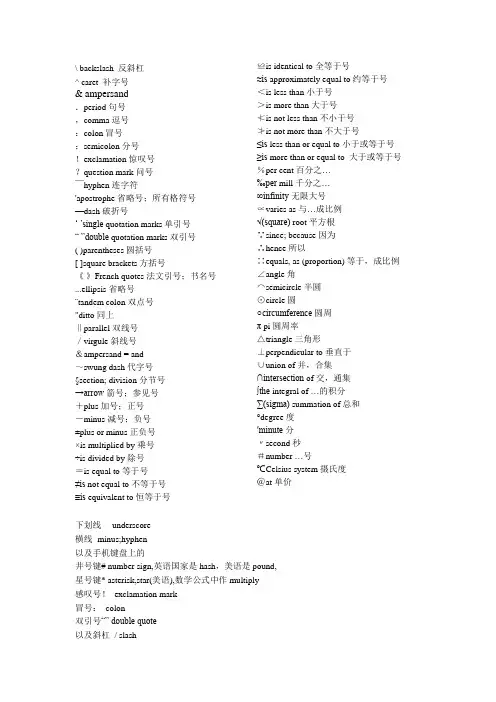
\ backslash 反斜杠^ caret 补字号& ampersand.period 句号,comma 逗号:colon 冒号;semicolon 分号!exclamation 惊叹号?question mark 问号 ̄hyphen 连字符'apostrophe 省略号;所有格符号—dash 破折号…‟single quotation marks 单引号“”double quotation marks 双引号( )parentheses 圆括号[ ]square brackets 方括号《》French quotes 法文引号;书名号...ellipsis 省略号¨tandem colon 双点号"ditto 同上‖parallel 双线号/virgule 斜线号&ampersand = and~swung dash 代字号§section; division 分节号→arrow箭号;参见号+plus 加号;正号-minus 减号;负号±plus or minus 正负号×is multiplied by 乘号÷is divided by 除号=is equal to 等于号≠is not equal to 不等于号≡is equivalent to 恒等于号≌is identical to 全等于号≈is approximately equal to 约等于号<is less than 小于号>is more than 大于号≮is not less than 不小于号≯is not more than 不大于号≤is less than or equal to 小于或等于号≥is more than or equal to 大于或等于号%per cent 百分之…‰per mill 千分之…∞infinity无限大号∝varies as 与…成比例√(square) root 平方根∵since; because 因为∴hence 所以∷equals, as (proportion) 等于,成比例∠angle 角≲semicircle 半圆≰circle 圆○circumference圆周π pi 圆周率△triangle 三角形≱perpendicular to 垂直于∪union of 并,合集∩intersection of 交,通集∫the integral of …的积分∑(sigma) summation of 总和°degree 度′minute分〃second 秒#number …号℃Celsius system 摄氏度@at 单价下划线_ underscore横线- minus;hyphen以及手机键盘上的井号键# number sign,英语国家是hash,美语是pound, 星号键* asterisk,star(美语),数学公式中作multiply感叹号!exclamation mark冒号:colon双引号“” double quote以及斜杠/ slash。

2019年考研《英语》长难句解析【五篇】( 2013年真题Section Ⅱ Reading Comprehension Part A Text 4 第5段第2句)The only major objection came from Justice Antonin Scalia, who offered an even more robust defense of state privileges going back to the Alien and Sedition Acts.为可追溯到《外国人法和煽动叛乱法》的州特权提供了更增强有力的辩护。
分析:本句的主干是…objection came from Justice Antonin Scalia…,后面接了一个由关系代词who引导的非限定性定语从句对宾语实行解释说明。
在该定语从句中,who是主语,指代Justice Antonin Scalia,谓语是offered,宾语是 an even more robust defense…。
of state privileges是defense的后置定语,而现在分词短语going back to the Alien and Sedition Acts是state privileges的后置定语,相当于定语从句which go back to the Alien and Sedition Acts。
词汇指南objection [əb'dʒekʃən](n.)反对,异议;不喜欢(CET-4)(2013年-阅读4)(ion-名词后缀)2个派生词:●objectivity ['ɔbdʒek'tivəti](n.)客观,客观性(超纲词汇)(2012年-阅读3)(ity-名词后缀)●objectiveness(n.)客观性(超纲词汇)(2010年-阅读4)(ness-名词后缀)robust [rəu'bʌst](adj.)强健的,强有力的;精力充沛的;结实的(超纲词汇)(2013年-阅读4)(ro=stronɡ-强壮的,bust=best-, → 壮的——即“强健的,强有力的”,引申为“精力充沛的;结实的”。

《民法大全》翻译中的标点符号翻译问题徐国栋厦门大学法学院教授关键词: 西文标点符号/中文标点符号/《民法大全》/翻译/定位符号内容提要: 本文证明,西文标点符号和中文标点符号部分具有各自的起源和个性,部分具有共同的起源和共性,由于两类标点符号系统起源和特性的差异,存在同形的标点符号不同用的现象,因而存在标点符号的翻译问题。
在这一前提下,本文探讨了把拉丁法律文献翻译为中文时的标点符号转换问题,尤其探讨了冒号和分号的翻译问题,并谈到了《民法大全》定位符号中的标点符号翻译问题。
从1989年开始,中国与意大利合作从拉丁语翻译《民法大全》为中文,经过近20年的工作,目前已出版《民法大全选译》12个分册。
从2000年开始,转入单个译者翻译《学说汇纂》单独的一卷的阶段,已出版《用益权》、《买卖契约》、《刑事法》、《正义与法·人的身份与物的划分·执法官》4卷。
总之,我们离把优士丁尼《民法大全》,尤其是其中的《学说汇纂》全部翻译成中文的目标越来越近,在这个时刻,停下来做一些翻译上的经验教训的研讨,可以为将来出版一部高质量的《民法大全选译》总合本创造条件。
我是《民法大全》翻译项目的参加者,从1994年开始至今,首先翻译了《民法大全选译》中的《法律行为》和《私犯之债和犯罪》两个分册,其次翻译了优士丁尼《法学阶梯》,在这些工作中积累了一些翻译经验和心得。
在就法律术语等方面的翻译已有许多人关注的情况下,我愿利用写作本文的机会关注一下法学界无人关注过的标点符号翻译问题,以图为一个宏大的事业做出自己的贡献。
一、西方标点符号的历史与《民法大全》使用的标点符号在古代西方世界,人们使用某种类似我们的标点符号的东西,例如,在公元前5世纪的希腊铭文中,用词连写,只是偶尔用直行的二连点和三连点分隔词句;到希腊化时代,亚历山大图书馆馆长阿里斯托芬(公元前257 - 前180年)创制出3级点号:即中圆点( · ) 、上圆点( # )和下圆点( . )表达停顿和分隔,这些为现在我们使用的标点符号的产生提供了条件。

以前在英语国家的合同起草中,一个最不寻常的地方就是法官们和律师们都觉得标点符号并不重要。
在普通法域国家中,他们普遍认为法律文件的意思确定应该是靠其文字和其语境,而潜伏在字里行间的标点符号并没有太大作用。
因此,旧式的法律文件中涉及到标点符号的地方极少,甚至根本就没有标点符号。
下面举例说明:This man said the judge is a fool.Woman without her man would be savage.Ok, 现在再来看一下加上标点符号以后的什么样子:This man, said the judge, is a fool.Woman – without her, man would be savage.值得高兴的是,现代的法律文件撰写人已经开始采用和普通撰写人一样的方式来使用标点符号了。
法律英语中的标点符号是法律英语写作和翻译中不可或缺的一个及其重要的部分。
所以我们决定专门设置一个页面,向大家介绍关于如何正确使用这些标点符号的方法,供大家学习参考。
下面我们就将最重要的标点符号逐一进行讲解。
一、句号(full stop/ period)英国英语管句号叫full stop, 而美国英语称之为period. 句号主要在以下四个场合使用。
第一种场合:在非疑问句和感叹句的句尾。
通常句号后面的下一个字母是有大写字母开头。
第二种场合:在缩写后。
如:’Sun. 10 August’.第三种场合:当句子以引用语结尾,并且该引用语自身已经带了句号,问号或者是感叹号,那么这里就不再需要使用另一个句号了。
但是,如果引用语本身很短,而且整句话比引用语更加重要的时候,可以在引号外面加一个句号。
如:On the door were written the words ‘no entry’.第四种场合:连续三个句号表示下文的省略。
这个时候如果加上第四个句号则表示整句话的结束。
如: ‘ … is exceptionally useful … I visit it every day.’二、逗号(commas)逗号用来表示一个句子中的简短停暂。
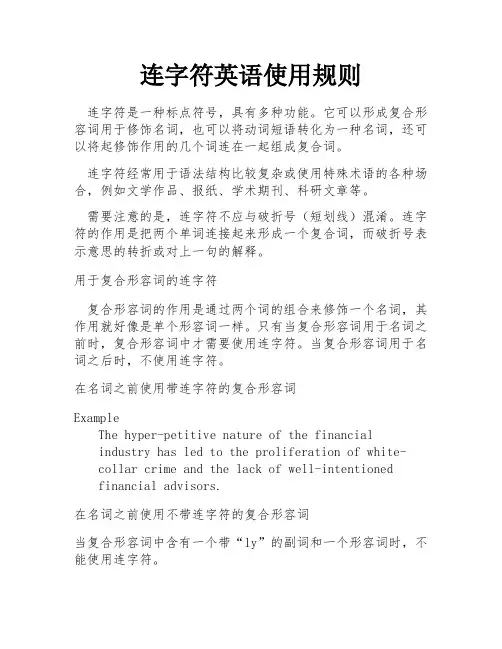
连字符英语使用规则连字符是一种标点符号,具有多种功能。
它可以形成复合形容词用于修饰名词,也可以将动词短语转化为一种名词,还可以将起修饰作用的几个词连在一起组成复合词。
连字符经常用于语法结构比较复杂或使用特殊术语的各种场合,例如文学作品、报纸、学术期刊、科研文章等。
需要注意的是,连字符不应与破折号(短划线)混淆。
连字符的作用是把两个单词连接起来形成一个复合词,而破折号表示意思的转折或对上一句的解释。
用于复合形容词的连字符复合形容词的作用是通过两个词的组合来修饰一个名词,其作用就好像是单个形容词一样。
只有当复合形容词用于名词之前时,复合形容词中才需要使用连字符。
当复合形容词用于名词之后时,不使用连字符。
在名词之前使用带连字符的复合形容词ExampleThe hyper-petitive nature of the financialindustry has led to the proliferation of white-collar crime and the lack of well-intentionedfinancial advisors.在名词之前使用不带连字符的复合形容词当复合形容词中含有一个带“ly”的副词和一个形容词时,不能使用连字符。
IncorrectOne overly-saturated area of finance is debtconsolidation, which targets mostly-young debtholders such as college students.CorrectOne overly saturated area of finance is debtconsolidation, which targets mostly young debtholders such as college students.在名词之后使用复合形容词时,不使用连字符当复合形容词出现在名词之后时,无需使用连字符。
英语中标点符号的用法大全-英文中符号英语中标点符号的用法大全1、逗号(comma) ,英文中逗号的作用和汉语是一样的。
另外,逗号还使用于用who 和which 的定于从句。
英文中的分号和逗号是同一符号。
分号隔开并列关系的单词和短语。
需要注意的是,使用了分号的短语一般最后一项内容前都是用了and或者Or,此时和汉语所不同的是and或Or前也应该使用分号(这是最最最常犯的语法错误之一,很多英语使用者都不知道) ,否则有可能造成歧义。
比如,猫、狗和牛应该是"cat, dog, and ox"而非"cat, dog and Ox"。
2 、句号(period) .英文中的句号的作用和汉语一样。
英文中的简写符号和句号是同一符号,比如Mr.、Ms.、etc.等等。
如果句号作为简写符号使用,那么这个词语简写前后面的符号应该照常写上,因为简写号并非句号,也不遵循句号的语法。
比如Entreprise Co., Ltd或者I inVited T om, Jerry, etc..(注意两个点)。
3 、冒号(colon)英文中的冒号的作用和汉语一样。
当冒号后是引用一个人说的话,也可以使用逗号。
4 、分号(semi-colon) ;英文中的分号的作用和汉语一样。
需要注意的是,分号和逗号有时是可以互相交替的,比如如下的情况。
Tom met me, and later he met Joan.Tom met me; later he met Joan.或Tom hates cheese, but he likes butter.Tom hates cheese; he like butter, though.当只有两个句子相并列时,分号可以和被逗号+连结词互替。
但注意第二个例子里,but 的转接意是需要用其他成份补充的。
5 、引号(quotation mark) 英文中的引号的作用和汉语一样,可用于引用和戏虐。
介绍法学专业的英语作文介绍法学Law is to open one of the categories of institutions of higher learning, one of Chinas top ten universities disciplines, including law, political science, public security science and sociology of four main parts.英语作文Law is also called the law, legal science, is based on law, legal phenomenon and its regularity of science that studies the content.It is the study of specialized knowledge and law related issues, is about the legal problems of knowledge and theory system. Law is about the science of law.The direct purpose of law, is to maintain social order, and by order of the construction and maintenance, to realize social justice.As take law as the research object of law, its core is in for the research of order and justice, is the knowledge of order and justice.[1]Legal thoughts first legalist philosophy originated from the spring and autumn period and the warring states period.The word law in China, the pre-qin period is referred to as "" study of forms, from the han dynasty began to have the name of the" law ".In the west, the ancient Roman jurists ulpian (Ulpianus) to "the law" (the ancient Latin words of Jurisprudentia) is defined as: and the god of the transaction, the concept of justice and injustice of learning.【英语作文mydream我想当一名律师.100词以上法律英语翻译-一个词!predecessorininterestpredecessorininterest可翻译成:“前利益相关人”。
英文破折号、连接号、连字符、负号的区别,注意事项和输入方法先看看这4个符号的长相,从左到右依次是:Hyphen , En dash , Em dash , Minus sign一、区别HYPHEN (-)1. 用于复合词,如:upper-case letter2. 用于分隔数字或字母,例如电话号码:1-800-621-2376或名字的拼写:My name is Phyllis; that's p-h-y-l-l-i-s.3. 用于排版时连接因断行而被打断的单词,例如:Trust Law ranks the Congo as one of the most dangerous coun-tries for sexual violence.EN DASH (–)1. 相当于to。
主要用于连接数字或单词,表示「到并包括」(up to and including)。
不过应注意,在from...to... 和between...and... 的结构中,不要用en dash 去替代中间的to 和and。
例句:Her college years, 1998–2002, were the happiest in her life.For documentation and indexing, see chapters 16–18.In Genesis 6:13–22 we find God's instructions to Noah.Join us on Thursday, 11:30 a.m.–4:00 p.m., to celebrate the New Year.The London–Paris train leaves at two o'clock.I have blocked out December 2002–March 2003 to complete my manuscript.Her articles appeared in Postwar Journal (3 November 1945–4 February 1946).Green Bay beat Denver 31–24.The legislature voted 101–13 to adopt the resolution.2. 后面什么也不接。
英语标点标点汉语标点Apostrophe ‟(撇号)Brackets [ ] 方括号Colon : 冒号Comma , 逗号Dash -(英)─(汉)破折号Ellipsis …(英)……(汉)省略号Exclamation mark ! 感叹号Hyphen - (连字号)Parentheses ( ) 圆括号Period/ Full stop .(英)。
(汉)句号Question mark ? 问号Quotation mark “”引号…‟Semicolon ; 分号Virgule / (斜线号)(英译为逗号)、顿号(英译时字母大写或使用斜体字). 着重号(英译时多词分写). 间隔号(英译时使用下划线或斜体字)《》书名号(英译时首字母大写)专名号Examine the following sentences, and pay special attention to the usage of quotation marks!1. He nodded and said, “Yes. I knew you would come.”他点头说道:“对。
我知道你会来。
”2. Without evincing any inclination to come in again, he theredelivered his valedictory remarks. They were these: “Well, Mr Pip, I think the sooner you leave here-as you are to be a gentleman-the better… Understand …”……他没有表达再度光临的一向,便发表了以下的告别演说:“呃, 匹普先生,我认为您越早离开这地方越好,因为您将成为一名绅士。
……”3. George rose. “Well. I think I‟d better go.”乔治站了起来。
法律英语中的破折号和连字符
在法律英语写作中,我们经常会遇到的破折号和连字符,应该在什么情况下使用才得当呢?
破折号 Dashes
有两种情况,我们可以使用破折号。
1. 把一个从句放在两个破折号之间。
例如:Very few – in fact almost none – of the lawyers working in this city haven‘t been to to study legal English.
上面例句中使用破折号可以使句子的意思清晰,而没有在此处用可能会使意思混淆的逗号。
2. 一个长的破折号可以用来作为‘to’的替代。
例如:The proposed route is Helsinki -- New York -- Helsinki.
连字符 Hyphens
使用连字符的情况也有两种。
1. 当第一个单词是第二个单词的前缀时,用连字符把两个单词合起来。
(特别是在英国英语中)
例如:Pre-trial, non-statutory. 这类词在美式英式
英语中通常就是一个单词,中间没有连字符:pretrial,nonstatutory.
2. 用在由一个以上单词构成的形容词短语上。
例如:health-care provider or real estate purchase.。